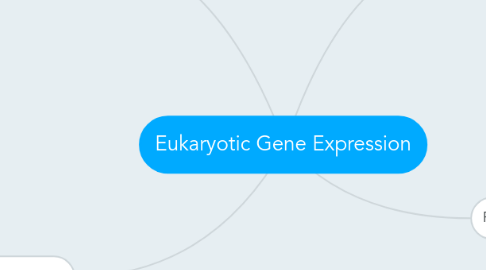
1. Regulation of Transcription Initiation
1.1. Organization of a Typical Eukaryotic Gene
1.1.1. transcription initiation complex on promotor, RNA polymerase II transcribes pre-mRNA, splicing
1.1.1.1. Control Elements: segments of noncoding DNA that regulate transcription by binding to certain proteins
1.2. The Roles of Transcription Factors
1.2.1. protein-protein interactions crucial
1.2.2. Enhancers and Specific Transcription Factors: enhancer: far away, protein bends DNA to make them interact
1.2.2.1. Specific Transcription Factors: repressors, bind directly to control element or block binding of activators to proteins that allow activators to bind to DNA
1.2.3. Combinatorial Control of Gene Activation
1.2.3.1. not many different control elements, but lots of combinations
1.3. Coordinately Controlled Genes in Eukaryotes
1.3.1. each gene transcribed on its own
1.3.2. co-expressed genes can code for metabolic pathway
1.3.3. steroids and growth factors causes coordinate control of dispersed Genes
2. Mechanisms of Post-Transcriptional Regulation
2.1. RNA Processing
2.1.1. Alternative RNA splicing: different genes created by same strand of pre-mRNA by treating different parts as introns and exons
2.1.2. mRNA Degradation
2.1.2.1. eukaryotes mRNA survive for long periods of time so they can be retranscribed
2.1.3. Initiation of Translation
2.1.3.1. some mRNAs can be blocked by regulatory proteins, preventing ribosomes from attaching
2.1.3.2. during development, cytoplasm adds adenosine to allow it to initiate translation
2.1.3.3. translation initiation factor initiates sudden burst of synthesis of proteins
2.1.4. Protein Processing and Degradation
2.1.4.1. after translation, regulatory proteins, hormones, or sugars added
2.1.4.2. proteasome: giant protein complexes that ubiquitin-tagged proteins and degrade them
3. Differential Gene Expression
3.1. expression of different genes by cells with the same genome
3.2. Regulated at transcription
4. Regulation of Chromatin Structure
4.1. Location of promotor relative to nucleosomes affects whether gene is transcribed
4.2. Heterochromatin not expressed
4.3. Histone Modifications
4.3.1. Acetylation: neutralizes charge, no binding, no folding, loose chromatin
4.3.2. histone code hypothesis: combination of modifications ( not just acetylation) determines chromatin structure
4.4. DNA Methylation
4.4.1. inactive DNA usually more methylated
4.4.2. proteins bind to methylated DNA and recruit histone deacetylation enzymes
4.4.3. genomic imprinting: methylation permanently regulates expression through generations
4.5. Epigenetic Inheritance
4.5.1. not directly involving DNA sequence
